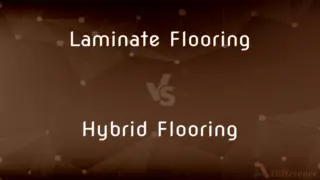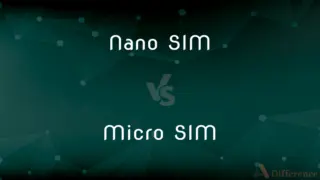Crucifix vs. Rood — What's the Difference?
By Tayyaba Rehman & Maham Liaqat — Updated on April 3, 2024
A crucifix is a cross with a representation of Jesus' body, focusing on Catholic veneration, whereas a rood is an old English term for any kind of cross, especially large ones in churches.

Difference Between Crucifix and Rood
Table of Contents
ADVERTISEMENT
Key Differences
A crucifix, typically found in Christian contexts, especially within Catholicism, prominently features the figure of Jesus Christ on the cross, symbolizing his crucifixion and emphasizing his suffering and sacrifice for humanity. On the other hand, the term "rood" originates from Old English and historically refers to any kind of cross, not necessarily bearing the figure of Jesus. Roods were often large, prominently displayed crosses in churches or monasteries, sometimes part of a "rood screen" separating the nave from the chancel.
This representation of crucifix serves not only as a religious symbol but also as an object of meditation and veneration for the faithful, highlighting the importance of Jesus’ death and its redemptive nature in Christian theology. Although a rood could bear a sculpture of the crucifixion, the term itself does not imply the presence of Jesus' figure, making it a more general reference to cross symbols within Christian tradition.
The crucifix is primarily associated with Roman Catholic, Eastern Orthodox, and some Anglican and Lutheran denominations, which emphasize the physical representation of Christ's suffering as a central element of worship and devotion. The detailed depiction of Christ on the crucifix serves to remind believers of the personal and physical sacrifice he made, encouraging empathy, reflection, and spiritual connection. Conversely, the use of the term rood has become less common in modern times, often retained in historical or liturgical contexts. When roods are present in contemporary Christian worship spaces, they may or may not include a figure of Christ, reflecting the broader and more inclusive definition of the term as any cross. This distinction underscores the variability in Christian symbolism and the evolution of religious practices and artifacts over time.
While the crucifix is a specific type of cross that explicitly depicts the crucifixion of Jesus Christ, making it a powerful symbol of Christian faith and devotion, a rood represents a broader category of cross symbols within Christianity. This difference illustrates the diversity of religious expression and the significance of particular symbols in fostering spiritual reflection and community identity among believers.
Comparison Chart
Definition
A cross with a representation of Jesus’ body.
An old English term for any kind of cross.
ADVERTISEMENT
Symbolism
Emphasizes Jesus' suffering and sacrifice.
Symbolizes Christianity more generally.
Use in Worship
Common in Catholic and Orthodox churches.
Used in churches, often part of rood screens.
Representation
Always includes Jesus.
May or may not include a figure.
Historical Context
Associated with medieval to modern Christianity.
Predominantly used in early medieval England.
Compare with Definitions
Crucifix
Often made of wood, metal, or stone, and can be found in various sizes.
The wooden crucifix was intricately carved, showcasing the artist's devotion.
Rood
Could be made of wood, stone, or metal, often part of a larger architectural structure.
The rood was carved from oak, dominating the church's interior with its size and craftsmanship.
Crucifix
Primarily used in Catholic and Orthodox Christian practices for veneration.
During the service, parishioners knelt before the large crucifix to pray.
Rood
Positioned prominently within the church, sometimes above a rood screen.
The rood stood at the chancel arch, visible to all who entered the sanctuary.
Crucifix
Represents the sacrifice of Jesus and his role in human salvation.
The crucifix hanging in her room reminded her of the sacrifices made for her faith.
Rood
Historically used in Christian churches in England, especially before the Reformation.
The rood screen separated the choir from the nave, a common feature in medieval churches.
Crucifix
Commonly placed above altars, in homes, or worn as jewelry.
He wore a small crucifix on a necklace as a symbol of his faith.
Rood
An old English term for a cross, often large and placed in a church.
The ancient church was known for its magnificent rood, towering over the congregation.
Crucifix
A cross with a depiction of Jesus Christ on it, symbolizing his crucifixion.
The crucifix above the altar became the focal point of the church's interior design.
Rood
Signifies Christianity broadly, without specific emphasis on Christ's crucifixion.
The presence of a rood in the church symbolized the community's Christian beliefs.
Crucifix
A cross viewed as a symbol of Jesus's crucifixion.
Rood
A rood or rood cross, sometimes known as a triumphal cross, is a cross or crucifix, especially the large crucifix set above the entrance to the chancel of a medieval church. Alternatively, it is a large sculpture or painting of the crucifixion of Jesus.
Crucifix
A crucifix (from Latin cruci fixus meaning "(one) fixed to a cross") is an image of Jesus on the cross, as distinct from a bare cross. The representation of Jesus himself on the cross is referred to in English as the corpus (Latin for "body").The crucifix is a principal symbol for many groups of Christians, and one of the most common forms of the Crucifixion in the arts.
Rood
(Archaic) The cross on which Jesus was crucified.
Crucifix
An image or figure of Jesus on the cross.
Rood
A crucifix, especially one surmounting the rood screen or rood beam of a medieval church.
Crucifix
A wooden cross used for crucifixions, as by the Romans. Category:en:Capital punishment
Rood
Chiefly British A measure of length that varies from 5 1/2 to 8 yards (5.0 to 7.3 meters).
Crucifix
An ornamental or symbolic sculptural representation of Christ on a cross, often worn as a pendant or displayed in a Christian church.
Plain crosses are preferred by Protestants, but crucifixes by Catholics.
Rood
A measure of land equal to 1/4 acre, or 40 square rods (0.10 hectare).
Crucifix
(gymnastics) The iron cross, a position on the rings where the gymnast holds the rings straight out on either side of the body.
Rood
(archaic) A crucifix, cross, especially in a church.
Crucifix
A representation in art of the figure of Christ upon the cross; esp., the sculptured figure affixed to a real cross of wood, ivory, metal, or the like, used by the Roman Catholics in their devotions.
The cross, too, by degrees, become the crucifix.
And kissing oft her crucifix,Unto the block she drew.
Rood
A measure of land area, equal to a quarter of an acre.
Crucifix
The cross or religion of Christ.
Rood
An area of sixty-four square yards.
Crucifix
Representation of the cross on which Jesus died
Rood
A measure of five and a half yards in length.
Crucifix
A gymnastic exercise performed on the rings when the gymnast supports himself with both arms extended horizontally
Rood
A representation in sculpture or in painting of the cross with Christ hanging on it.
Savior, in thine image seenBleeding on that precious rood.
Rood
A measure of five and a half yards in length; a rod; a perch; a pole.
Rood
The fourth part of an acre, or forty square rods.
Rood
Representation of the cross on which Jesus died
Common Curiosities
What is a crucifix?
A crucifix is a Christian cross with a representation of Jesus’ body on it, symbolizing his crucifixion.
Can a rood have a figure of Jesus on it?
Yes, a rood can have a figure of Jesus on it, although its definition doesn’t specifically require one.
How did the use of roods change after the Reformation?
After the Reformation, the use of roods and rood screens diminished, especially in Protestant churches, due to changing theological perspectives.
Where are crucifixes commonly used?
Crucifixes are commonly used in Catholic and Orthodox churches, as well as in private Christian devotion.
Are roods still made today?
Yes, roods are still made, often for historical churches or for those wishing to maintain traditional decor.
How does the crucifix reflect Christian doctrine?
The crucifix reflects Christian doctrine by emphasizing the incarnation, crucifixion, and resurrection of Jesus as central to salvation.
What does "rood" mean?
"Rood" is an old English term for any kind of cross, often used historically to refer to large crosses in churches.
Can crucifixes be found outside of churches?
Yes, crucifixes can be found in Christian homes, schools, and as personal jewelry, symbolizing personal faith.
What is the significance of a rood in a church?
A rood, especially when part of a rood screen, historically served to distinguish and sanctify the chancel area from the nave in a church.
Is the crucifix worn only by clergy?
No, crucifixes are worn by both clergy and laypeople as a symbol of their faith.
Why is the crucifix important in Christian worship?
The crucifix serves as a vivid reminder of Jesus’ suffering, sacrifice, and the salvation he offers to humanity.
What materials are roods made from?
Roods can be made from wood, stone, or metal, depending on their size and the artistic traditions of the time.
What is the purpose of a rood screen?
A rood screen traditionally separated the chancel, where the clergy performed the liturgy, from the nave, where the congregation gathered.
How do crucifixes vary in design?
Crucifix designs can vary widely, from simple wooden crosses to elaborate metal or stone works adorned with jewels.
Why might someone prefer a simple cross to a crucifix?
Some Christians prefer a simple cross as a symbol of faith, focusing on the resurrection rather than the crucifixion of Jesus.
Share Your Discovery

Previous Comparison
Crt vs. Lcd
Next Comparison
Character vs. DigitAuthor Spotlight
Written by
Tayyaba RehmanTayyaba Rehman is a distinguished writer, currently serving as a primary contributor to askdifference.com. As a researcher in semantics and etymology, Tayyaba's passion for the complexity of languages and their distinctions has found a perfect home on the platform. Tayyaba delves into the intricacies of language, distinguishing between commonly confused words and phrases, thereby providing clarity for readers worldwide.
Co-written by
Maham Liaqat














































